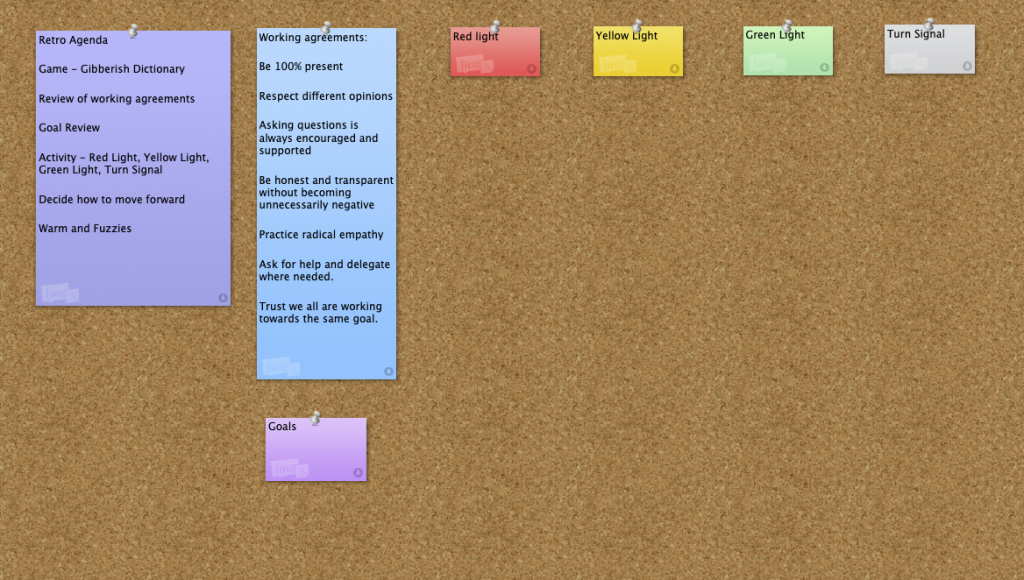Team retrospectives are a great way to check in with your team to see how they are doing and how the project is progressing. Retros usually happen between “iterations,” and take place bi-weekly or monthly. They provide time for everyone to gather in person or online and review the goals set for that iteration. Everyone is on equal footing during this meeting. It is a safe space to be open and constructive with each other to help move everyone forward. It’s typically done in person but is easily transferable to Zoom or Google Meet. If the retro is for an iteration of one to two weeks, it’s best to keep the retrospective no longer than an hour.
I am a Retro Facilitator, and this is how I ran a recent retrospective with our clients.
Greeting (5 minutes)
- I welcome everyone to the retro and do some small talk while we wait for any last-minute stragglers.
Game (5 minutes)
- After everyone has settled in, I guide them through a game to get everyone talking and the creative juices flowing.
- This time, I choose Giberish Dictionary. I have everyone take turns giving a made-up word and their definition for the made-up word. It generates some laughs from those participating.
Review Working Agreements and goal (1 minute)
- Before we get into the activity, we review the working agreements that the team had put together during our first meeting. These are the guidelines that everyone created to provide security and freedom within the retros.
- Then, I go over the agreed upon goals from the last retro which will be the topic of the activity.
Activity (2 minutes explaining, 15 minutes)
- Alright, let’s get to the meat of the retro, the activity. Here, we digest the information from the iteration and see what we can do to move forward.
- There are plenty of websites that have great activities your team can do, but when you run retros regularly, you can make them up as you go.
- Today’s activity is one that I made up myself. It’s called Red Light, Green Light, Yellow Light, Turn Signal. It’s a bulky name, I know, but it lends itself to the interpretation.
- If you are in person, this game would require a whiteboard and some sticky notes. When I do mine online, I use an online post-it note website that allows for live interaction among the participants. I send the link to the board I made ahead of time, just before the meeting starts.

- Once everyone has joined, I explain the activity.
- The Red Light signifies the things the team did that stopped forward movement.
- Green Light is the actions the team did to keep the iteration going.
- Yellow Light stands for what slowed the team down from reaching the goal of the iteration.
- The Turn Signal is for the things that got the team off track and away from reaching the goal.
- After explanations, I step back and let the team go to work on writing their sticky notes and placing them under each category. I make sure to set a timer so that we don’t enjoy the silence for too long!
- Important note: Even if everyone seems to be done early, I let the time conclude to give team members a chance to think over the details of the past weeks.
Generate insights (10-15 minutes)
- Once the timer goes off, I let everyone finish up what they were writing and move on to the review.
- We go through the list of post-its one by one and let the team decide if they want to add or elaborate on any of the topics. This is one of my favorite parts of the retro because it can get a good discussion going on what problems have been seen or seeing the joy in a team member’s face when they’re accomplishments have been acknowledged.
Decide what to do (10 minutes)
- After looking at the results of the last step, the changes that need to be made can be pretty obvious from the Red Light, Yellow Light, or Turn signal categories.
- Now is the to decide what problems need to be addressed during the next iteration. When there are too many problems to reasonably work on, a vote or a discussion is held to narrow down the list.
Warm Fuzzies (remaining time)
- I take the remaining time to review the results of the retro and thank everyone for their time and contributions.
- We then agree on the time and date of the next retro and make our farewells.
Retrospective can have an amazing impact on your team when done regularly and respectively. One hour every other week can have a big impact on the cohesiveness of your team. Give your company a brighter, happier future by giving retros a try.
For more information on learning to lead your own retro one day, check out Agile Retrospectives: Making Good Teams Great. If you're ready to get started, reach out to have us lead your team retrospectives.

